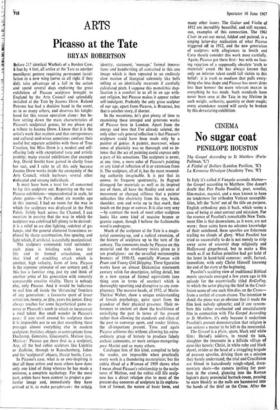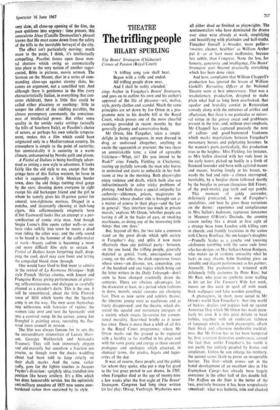CINEMA
No sugar coat
PENELOPE HOUSTON
A Fistful of Dollars (London Pavilion, 'X') La Kermesse Heroique (Academy Two, 'X') In Italy it's called 11 Vangelo secondo Matteo- the Gospel according to Matthew. One doesn't doubt that Pier Paolo Pasolini, poet, novelist, film-maker, marxist, and a man known to have no tenderness for orthodox Vatican susceptibi- lities, left the 'Saint' out of the title on purpose. English orthodoxy puts it back, which seems a case of being at once correct and mistaken. For the essence of Pasolini's remarkable New Testa- ment film is that decorations, as it were, are not worn: these saints have no advance knowledge of their sainthood, these apostles are fishermen trailing no clouds of glory. What Pasolini has tried so successfully to do is not merely to strip away acres of souvenir shop religiosity and Hollywood gingerbread, but to make a film much as if an Italian primitive had got hold of the latest in hand-held cameras: swift, factual, immediate, with only Christ Himself knowing the end of the story at the beginning.
Pasolini's scalding view of traditional Biblical movie spectacle emerged a few years ago in his episode for the eccentrically titled RoGoPag, in which the actor playing the thief in the Cruci- fixion scene of one such film dies on the Cross— from a surfeit of cream cheese. The intention to shock the pious was so obvious that it made the film look naively splenetic; and if one remem- bers this rather overheated and unsatisfactory film in connection with The Gospel According to St Matthew, it's only because it underlines Pasolini's present demonstration that religion is too serious a matter to be left to the reverential.
The Gospel is a plain, spare, black and white film: Herod's soldiers, in round tin hats, slaughter the innocents in a hillside village of cave-like hovels; Christ, in white robe and black shawl, strides at the head of a straggling brigade of peasant apostles, driving them on a mission they barely understand; the trial and Crucifixion are filmed in hazardously rough-edged, docu- mentary shots—the camera jostling for posi- tion in the crowd, glancing into the Roman legion's dusty provincial barrack-room, pausing to stare bleakly as the nails are hammered into the hands of the thief On the Cross. After the
very slow, all close-up opening of the film, the pace quickens into urgency: time presses, this sansculotte Jesus (Camille Desmoulins's phrase) knows that He must comedown from the safety of the hills to the inevitable betrayal of the city.
The effect isn't particularly moving: much more to the point, I think, it's intellectually compelling. Pasolini forces open those men- tal shutters which swing so automatically into place at the very notion of another sugar- coated, Bible in pictures, movie sermon. The Sermon on the Mount, shot in a series of com- manding close-ups against stormy skies, be- comes an argument, not a sanctified text. And although there is gentleness in the film (very characteristically Italian, in everything that con- cerns children), there is little that could be called either placatory or soothing: little to temper the effect of the riddling parables, the almost peremptory commands, the conscious- ness of intellectual power. But either some quality in the untidy rocky settings (actually the hills of Southern Italy), or Pasolini's choice of actors, or perhaps his own volatile tempera- ment, makes this a film which could have originated only in a Mediterranean country. Its atmosphere is simple to the point of austerity; but unmistakably it is austerity in a warm climate, unhampered by Nordic guilt and gloom.
A Fistful of Dollars is being bustlingly adver- tised as setting a new style in adventure. It looks fairly like the old style to me, except that the gringo hero of this Italian western, let loose in what is supposedly a little Mexican border town, does the old things (setting rival gangs by the ears; shooting down everyone in sight except his old barkeeper friend and the girl to whom he tamely gives his ill-gotten gains) for amoral, non-righteous motives. Draped in a poncho, and incessantly chewing at inch-long cigars, this selfconsciously enigmatic hero (Clint Eastwood) looks like an attempt at a per- sonification of comic strip man. And though Sergio Leone's film opens rather well—as our hero rides sulkily into town he meets a dead man riding the other way; and the only sound to be heard is the hammer of the coffin-maker at work—breezy sadism is becoming a more and more difficult film style to sustain. A Fistful of Dollars keeps forgetting itself, drop- ping the cool, devil may care front and letting the congealed blood show through.
One would have liked to find more to admire in the revival of La Kermesse Heroique—high style French 'thirties cinema, with Jouvet and Francoise Rosay giving performances of glitter- ing selfconsciousness, and dialogue as carefully planted as a picador's darts. This is the one, it will be remembered, about the little Flemish town of 1616 which learns that the Spanish army is on the way. The men scare themselves into witlessness with fantasies of rapine; the women take over and turn the Spaniards' visit into a carnival romp. In the corner, young Jan Brueghel is painting away, recording the flus- tered town council in session. . . .
The film was always famous for its sets (by the extraordinary triumvirate of Lazare Meer- son, Georges Wakhevitch and Alexandre Trauner). They still look immensely elegant and old-masterly but somehow a fraction too precise, as though even the ducks waddling about had been told to keep strictly on their chalk marks. And the same, rather sadly, goes for the lighter touches in Jacques Feyder's direction: sprightly ideas trundled into position like heavy artillery. It's a film which has done honourable service, but the optimistic anti-military anecdote of 1935 now seems over- burdened rather than sustained by its style.



































 Previous page
Previous page